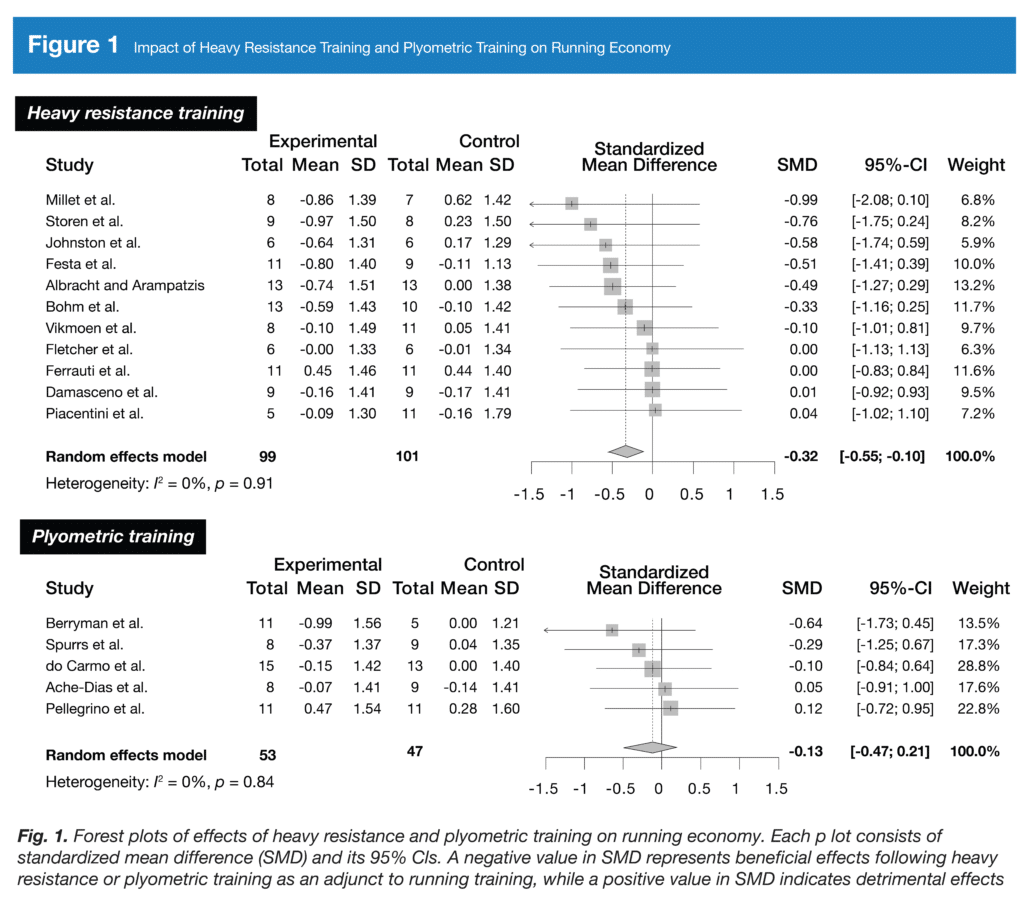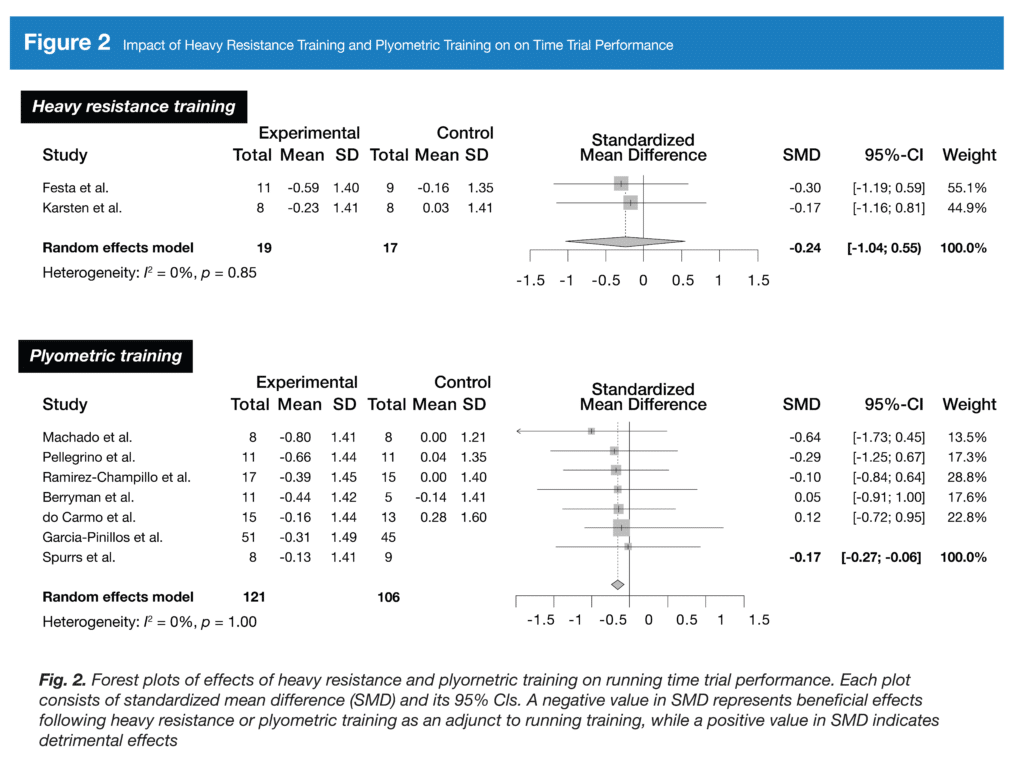While most SBS readers lift weights for the express purpose of building strength and muscle mass, resistance training is used in a variety of other athletic pursuits. For example, resistance training is often employed by runners to improve running economy and reduce injury risk (2).
Running economy refers to the energy requirements to run at a particular pace. For example, if you expend 18 kilocalories per minute to maintain a running speed of 10 miles per hour (16 kilometers per hour), and your training partner only expends 15 kilocalories per minute to maintain a running speed of 10 miles per hour, your training partner is a more economical runner – they burn less energy to run at the same speed. Similarly, if your running technique improves, you might be able to maintain the same 10 mile per hour pace while only expending 16 kilocalories per minute, thus resulting in improved running economy. All else being equal, an improved running economy should directly improve running performance – if your running economy improves by 5%, you should be able to run about 5% faster over any given distance. Of note, running economy is usually quantified using relative VO2 (in milliliters of oxygen consumed, per kilogram, per minute), so this paragraph presents you with a slightly simplified example, but it should be sufficient to ensure that people without an endurance training background understand the general concept of running economy.
Resistance training is thought to improve running economy primarily via increasing the stiffness of the musculotendinous unit. Stiffness describes a tissue’s ability to resist a change in length. A stiffer muscle stores more elastic energy when it’s forced to change in length, thus requiring less active contractile force to shorten again. Active contractile force generation requires chemical energy to be consumed, while passive elastic force generation doesn’t.
You can think of passive elastic forces like a rubber band. When your foot makes contact with the ground, the resulting eccentric forces cause your quads and calf muscle to lengthen, which is analogous to stretching a rubber band. The energy to stretch the rubber band doesn’t come from breaking down glycogen and using ATP – it comes directly from the mechanical forces your muscles experience as your foot strikes the ground. That energy is then released during the concentric phase (pushoff) as your muscles shorten, like a rubber band snapping back to its resting length. You can think of stiffer muscles as thicker rubber bands – it takes more energy to stretch them in the first place, but they also snap back with more elastic force during concentric contractions.
The force you can’t generate via passive elastic forces has to come from active contractile forces, which do require glycogen and ATP to be used. So, all else being equal, stiffer muscles have a reduced reliance on active contractile forces when running at a particular speed, thus reducing energy usage and improving running economy.
Normal resistance training and plyometrics have both been proposed as adjuvants to endurance training for the purpose of improving running economy. Furthermore, it has been theorized that really heavy resistance training should result in larger increases in musculotendinous stiffness than lighter resistance training, and thus result in larger improvements in running economy. The present meta-analysis by Eihara and colleagues sought to summarize the literature around these topics, to better inform resistance training exercise prescription for runners (1).
The authors began by identifying studies meeting these criteria:
- The studies needed to focus on healthy, trained middle- or long-distance runners not using ergogenic substances as part of the intervention. Non-runners, runners with less than six months of training experience, and untrained subjects were excluded. Cross-country runners, triathletes, and duathletes were included.
- The studies needed to compare a group doing both resistance training and running training to a group doing only running training. The running training needed to be similar between groups.
- The resistance training interventions needed to employ either heavy resistance training (>70% of 1RM, <12RM loads, or >70% of maximum contractile force) or plyometric training in isolation. A study would be excluded if it investigated the effects of a combination of heavy and lighter resistance training, a combination of heavy resistance training and plyometrics, etc.
- The training interventions needed to last for at least 6 weeks.
- The studies needed to assess running economy pre- and post-training at a submaximal speed (respiratory exchange ratio < 1.0), or time trial performance pre- and post-training.
- The study needed to be published in a peer-reviewed journal, and report on the details of the training interventions in adequate detail.
22 studies met these inclusion criteria, including 16 assessing changes in running economy, and nine assessing changes in time trial performance.
After identifying these studies, the researchers performed four meta-analyses (impacts of heavy resistance and plyometric training on both running economy and time trial performance), and several moderator analyses (to identify specific variables that predicted larger versus smaller improvements in running economy).
Heavy resistance training significantly improved running economy to a small degree (SMD = 0.32; 95% CI = 0.10-0.55), whereas plyometric training led to a trivial, non-significant improvement in running economy (SMD = 0.13; 95% CI = -0.21-0.47; Figure 1).

Heavy resistance training led to a small, non-significant improvement in time trial performance (SMD = 0.24; 95% CI = -0.55-1.04), while plyometric training led to a trivial, statistically significant improvement in time trial performance (SMD = 0.17; 95% CI = 0.06-0.27; Figure 2).

Finally, in the moderator analyses, really heavy resistance training (>90% of 1RM, or <4RM) seemed to improve running economy more reliably to to a larger degree than somewhat lighter resistance training (70-89% of 1RM, or 5-12RM), and longer training interventions (at least 10 weeks for heavy resistance training, and at least 8 weeks for plyometric training) led to larger improvements in running economy than shorter training interventions.
My basic takeaway from this meta-analysis is that both heavy resistance training and plyometric training may improve running economy and performance. I’m not too hung up on whether a particular analysis returned a statistically significant result or not, because the analyses that returned non-significant results didn’t include many studies, and were thus likely underpowered – only five studies examined the impact of plyometrics on running economy, and only two studies examined the effects of heavy resistance training on time trial performance. However, we know that plyometric training reliably increases muscle stiffness (so it should improve running economy; 3), and it would be surprising if heavy resistance training did significantly improve running economy but not time trial performance.
Based on the results of this study, if I had to give the nod to a single resistance training modality for runners, it would probably be particularly heavy (>90% of 1RM, or <4RM) resistance training. However, I’d also be quite surprised if the impact of different training interventions on muscle stiffness – and thus running economy – didn’t vary considerably between individuals. In other words, I anticipate that heavy resistance training will pay larger dividends for some runners, and plyometrics will pay larger dividends for others. I can’t think of a good reason to not try both.
As a practical recommendation, I’d recommend easing into heavy resistance training and/or plyometric training if you’re already doing a considerable amount of running. Runners already have pretty high rates of overuse injuries (4), so be conservative when adding in another training-related stressor. Start with one weekly session consisting of just two or three sets of plyometrics or resistance exercises targeting the knee extensors, hip extensors, and ankles. If your feet, ankles, knees, and hips tolerate that level of volume, you can gradually build up from there. If they don’t, then scale back the intensity until you find a starting point to build from. There’s not much research examining the optimal volume of resistance or plyometric training for improving running performance, but a volume 2-6 sets, 2-4 times per week is commonly used in the research, and seems to be effective. Finally, don’t expect heavy resistance training or plyometric training to improve your running performance overnight – this meta-analysis suggests that the benefits accrue over time, with noticeable improvements coming after at least 8-10 weeks of training.
If you’d like to read more on this topic, I’d highly recommend these three reviews, all of which are accessible for free (2, 5, 6).
Note: This article was published in partnership with MASS Research Review. Full versions of Research Spotlight breakdowns are originally published in MASS Research Review. Subscribe to MASS to get a monthly publication with breakdowns of recent exercise and nutrition studies.
References
- Eihara Y, Takao K, Sugiyama T, Maeo S, Terada M, Kanehisa H, Isaka T. Heavy Resistance Training Versus Plyometric Training for Improving Running Economy and Running Time Trial Performance: A Systematic Review and Meta-analysis. Sports Med Open. 2022 Nov 12;8(1):138. doi: 10.1186/s40798-022-00511-1. PMID: 36370207; PMCID: PMC9653533.
- Šuc A, Šarko P, Pleša J, Kozinc Ž. Resistance Exercise for Improving Running Economy and Running Biomechanics and Decreasing Running-Related Injury Risk: A Narrative Review. Sports (Basel). 2022 Jun 24;10(7):98. doi: 10.3390/sports10070098. PMID: 35878109; PMCID: PMC9319953.
- Ramírez-delaCruz M, Bravo-Sánchez A, Esteban-García P, Jiménez F, Abián-Vicén J. Effects of Plyometric Training on Lower Body Muscle Architecture, Tendon Structure, Stiffness and Physical Performance: A Systematic Review and Meta-analysis. Sports Med Open. 2022 Mar 21;8(1):40. doi: 10.1186/s40798-022-00431-0. PMID: 35312884; PMCID: PMC8938535.
- Willwacher S, Kurz M, Robbin J, Thelen M, Hamill J, Kelly L, Mai P. Running-Related Biomechanical Risk Factors for Overuse Injuries in Distance Runners: A Systematic Review Considering Injury Specificity and the Potentials for Future Research. Sports Med. 2022 Aug;52(8):1863-1877. doi: 10.1007/s40279-022-01666-3. Epub 2022 Mar 5. PMID: 35247202; PMCID: PMC9325808.
- Blagrove RC, Howatson G, Hayes PR. Effects of Strength Training on the Physiological Determinants of Middle- and Long-Distance Running Performance: A Systematic Review. Sports Med. 2018 May;48(5):1117-1149. doi: 10.1007/s40279-017-0835-7. PMID: 29249083; PMCID: PMC5889786.
- Rønnestad BR, Mujika I. Optimizing strength training for running and cycling endurance performance: A review. Scand J Med Sci Sports. 2014 Aug;24(4):603-12. doi: 10.1111/sms.12104. Epub 2013 Aug 5. PMID: 23914932.




